ChatGPT Education Use Cases, Benefits & Challenges in 2024
Teachers and lecturers across many educational levels are afraid of ChatGPT‘s possible negative impacts on academic integrity. They fear that the chatbot is going to increase plagiarism and spread academic dishonesty.
For academics in the Rochester University, ChatGPT and other similar LLMs are in the “yellow” category of higher education online educational tools, meaning students should be careful while using them.1 On the other hand, some welcome the tool with more optimism. For example, Cambridge University released an article on ChatGPT education opportunities and challenges.2
Despite the fear or high hopes, it is a fact that ChatGPT is changing the traditional learning process and forcing everyone to rethink and remodel education besides other generative AI technologies. In this article, we gathered ChatGPT education use cases for teachers and students, and also explained its benefits and challenges to education.
Top 7 ChatGPT Education Use Cases
For Teachers
1- Content creation
ChatGPT is a valuable tool to teach students effectively and engagingly. It can help teachers generate ideas for lesson plans, activities, and projects that align with specific learning objectives and curricular standards.
Also, teachers can use ChatGPT to create and curate educational materials, such as presentations, worksheets, quizzes, and other resources tailored to their students’ needs (Figure 1).
Figure 1. ChatGPT creates a quiz for a class
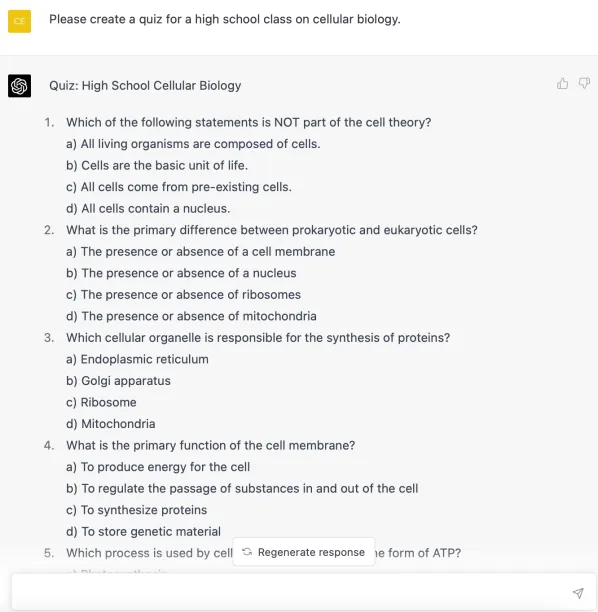
Explore more use cases and case studies regarding AI text generation.
2- Grammar and writing check
Another use case of ChatGPT for teachers involves leveraging the AI’s natural language understanding capabilities to assist in evaluating and improving the quality of written work. This can be applied in various ways:
- Proofreading and editing: Teachers can use ChatGPT to quickly review and correct spelling, grammar, punctuation, and syntax errors in their own written materials, such as lesson plans, handouts, or email communications.
- Providing feedback to students: ChatGPT can assist teachers in reviewing student essays, reports, or other written assignments, identifying areas that need improvement and providing specific feedback on grammar, sentence structure, and word choice.
- Teaching writing skills: Teachers can use ChatGPT to generate examples and explanations of grammar rules, punctuation usage, and other writing conventions, helping students improve their writing skills.
3- Grading
ChatGPT can assist teachers in reviewing and grading student essays by analyzing the content, structure, and coherence of the writing. The AI can provide feedback on grammar, spelling, punctuation, and syntax, as well as assess the quality of the argument or analysis presented. However, it is important to not rely merely on ChatGPT while grading. Rather, teachers can use ChatGPT for determining the rubric for grading.
4- Designing syllabus outline
Teachers can incorporate ChatGPT by leveraging the AI’s capabilities to help create, organize, and structure course content in a coherent and effective manner (Figure 2). ChatGPT can help in:
- Preparing course objectives and goals
- Topic generation
- Lesson planning
- Identifying and curating relevant resources and materials for the course
Figure 2. ChatGPT creates a course design on cellular biology
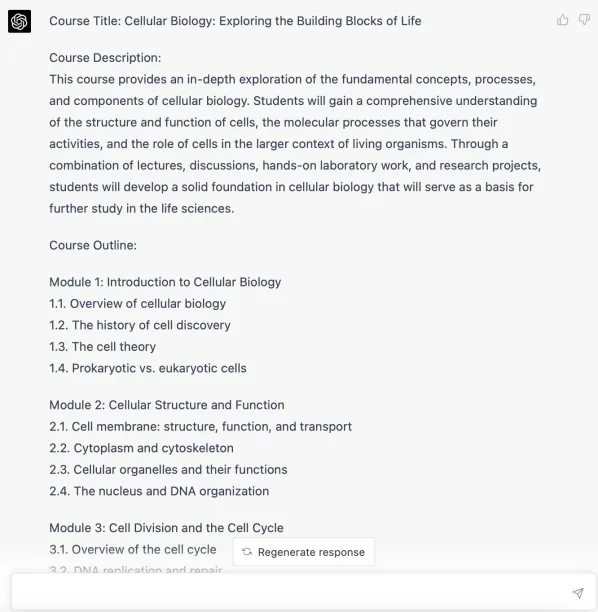
For Students
5- Help with homework
- Answering questions: Students can ask ChatGPT questions about specific topics or concepts they are struggling with, and the AI can provide explanations, examples, or resources to help clarify their understanding (Figure 3).
- Problem-solving: ChatGPT can increase the problem solving skills of students by guiding them through the steps of solving problems in subjects like mathematics, physics, or chemistry, helping them understand the underlying concepts and methods.
- Concept reinforcement: ChatGPT can provide additional examples, analogies, and explanations to reinforce students’ understanding of complex concepts or topics they are studying.
- Improving writing skills: Students can use ChatGPT to get suggestions for improving their essays, reports, or other written assignments, including feedback on grammar, sentence structure, word choice, etc. They can use the tool to write essays, craft the first draft of their written assignments, which can save time to improve the fine details and overall quality of the work.
Figure 3. ChatGPT explains some key concepts for a high school student
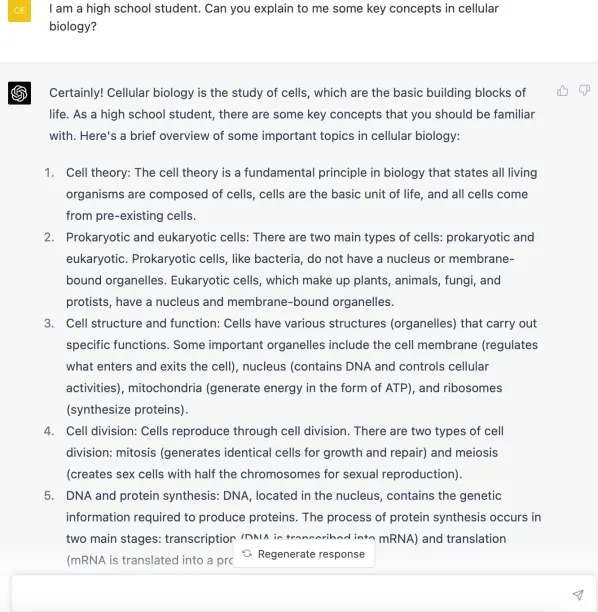
6- Research
ChatGPT can support and streamline the research process for various academic projects, assignments, or personal interests (Figure 4). It can facilitate many steps in a research process such as:
- Topic selection
- Background information about the topic
- Identifying relevant resources
- Organizing research
- Citation assistance.
Check out some real-life use cases and examples of generative AI in life sciences.
Figure 4. ChatGPT provides creative ideas for a term project
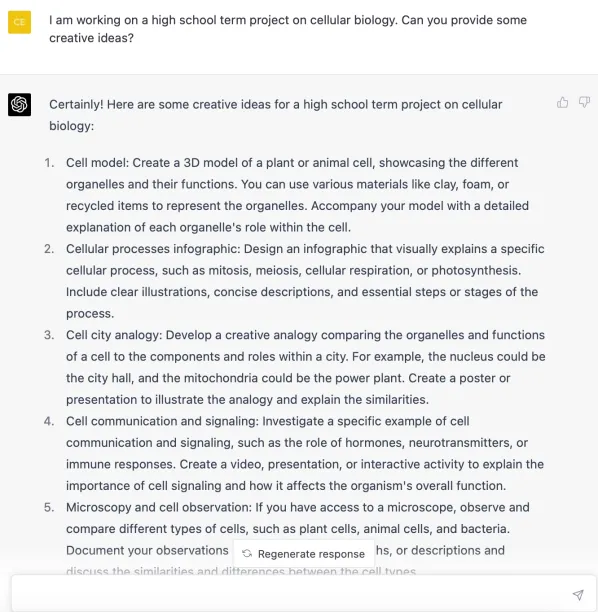
7- Language learning
ChatGPT can be a valuable tool for language learning, offering translations, grammar explanations, vocabulary practice, and conversation simulations to help students practice and improve their language skills.
Figure 5. ChatGPT schedules a program for improving language skills
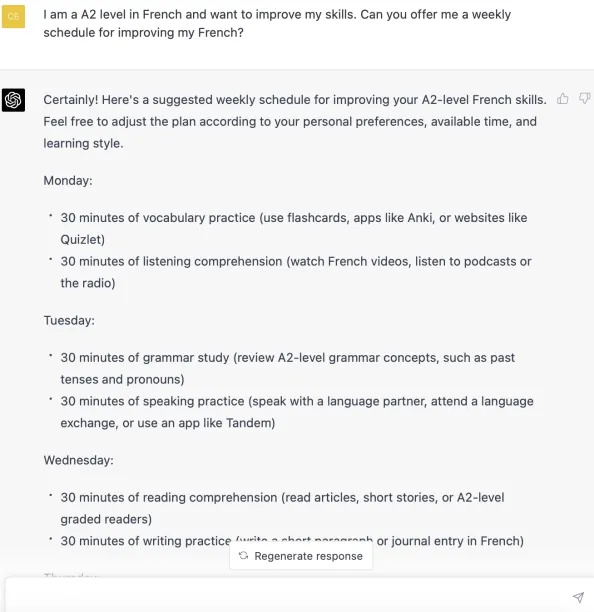
Benefits of ChatGPT for Education
Speed
Artificial intelligence tools like ChatGPT can process and generate information quickly, which can save time and increase efficiency for both teachers and students. It creates a valuable time for students to focus on other tasks by allowing the automation of instant feedback and quick access to information.
By assisting with tasks like
- grading
- lesson planning
- content creation
ChatGPT can save time for teachers, allowing them to focus more on direct instruction and student support. Learn how generative AI can automate certain tasks in education.
Availability
ChatGPT provides a readily available source of information and guidance, making it easier for students and teachers to access support when needed, regardless of time or location.
Personalized learning
ChatGPT can help create tailored learning experiences for students based on their individual needs, interests, and skill levels, allowing for more targeted instruction and improved learning outcomes.
Challenges of ChatGPT for Education
Although the chatbot has many capabilities, it also has some limitations and challenges. The video below shows how ChatGPT can fail in some educational tasks.
Here are some other potential challenges of ChatGPT for education:
Accuracy and reliability problems
ChatGPT may sometimes provide inaccurate or incomplete information, which could lead to misunderstandings or confusion for students and teachers.
Possible biases
AI technologies like ChatGPT can inherit biases from the data they are trained on, which may result in biased or unrepresentative content generation that could impact teaching and learning negatively.
Risk of decrease in original and critical thinking skills
The convenience and speed of ChatGPT might lead to an over-reliance on AI-generated content and reduce critical thinking, problem-solving, and creativity in the educational process.
Discover all legal concerns, ethical issues and other risks of generative AI and how to mitigate them.
If you have questions or need help in finding vendors, we can help:
External Links
- 1. “How will AI chatbots like ChatGPT affect higher education?” University of Rochester, 27 February 2023. Accessed 10 August 2023.
- 2. “ChatGPT: opportunities and challenges for education.” University of Cambridge, 5 April 2023. Accessed 10 August 2023.

Cem has been the principal analyst at AIMultiple since 2017. AIMultiple informs hundreds of thousands of businesses (as per similarWeb) including 60% of Fortune 500 every month.
Cem's work has been cited by leading global publications including Business Insider, Forbes, Washington Post, global firms like Deloitte, HPE, NGOs like World Economic Forum and supranational organizations like European Commission. You can see more reputable companies and media that referenced AIMultiple.
Throughout his career, Cem served as a tech consultant, tech buyer and tech entrepreneur. He advised businesses on their enterprise software, automation, cloud, AI / ML and other technology related decisions at McKinsey & Company and Altman Solon for more than a decade. He also published a McKinsey report on digitalization.
He led technology strategy and procurement of a telco while reporting to the CEO. He has also led commercial growth of deep tech company Hypatos that reached a 7 digit annual recurring revenue and a 9 digit valuation from 0 within 2 years. Cem's work in Hypatos was covered by leading technology publications like TechCrunch and Business Insider.
Cem regularly speaks at international technology conferences. He graduated from Bogazici University as a computer engineer and holds an MBA from Columbia Business School.
To stay up-to-date on B2B tech & accelerate your enterprise:
Follow on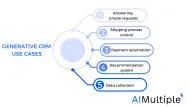
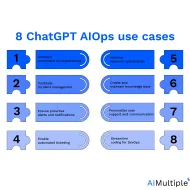
Comments
Your email address will not be published. All fields are required.